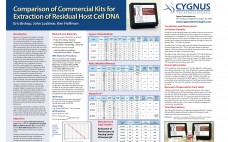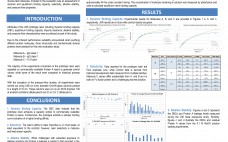Expression of therapeutic proteins in cultured cells is a cost effective method for production of commercial quantities of a drug substance. However, the manufacturing and purification process of these products leaves the potential for DNA contamination from the host cells. Due to the theoretical potential for the transfer of oncogenes from the host cell, the WHO has set a residual host cell DNA limit of 10ng/dose in biologic therapeutics. Regulatory agencies have set allowable limits between 100pg/dose and 10ng/dose depending…
Friday, November 2, 2012 Daily Archives
Improving Cell Culture Productivity with a SEGFLOW® Automated On-line Sampling and Feed System
A SEGFLOW® automated on-line sampling and feed system (SEGFLOW) was evaluated for its impact on Chinese Hamster Ovary (CHO) cell culture process performance in bench-scale stirred tank bioreactors. The SEGFLOW was integrated with a YSI® Biochemistry Analyzer and a nutrient feed pump allowing real-time glucose analysis and automated glucose feeding to be performed for the test batch. In contrast, a batch using daily manual sampling and bolus feed protocols, was performed as a control. For the SEGFLOW culture, media glucose…
New Core Bead Chromatography Medium Enables Group Separation and High Productivity Purification of Large Molecules
When large biomolecules such as IgM or influenza virus are purified, group separation with gel filtration is the most commonly used technique. Advantages of using gel filtration include the high purity and the high recoveries that can be achieved, while a drawback is the relatively low productivity. Captoâ„¢ Core 700 is a chromatography medium (resin) from GE Healthcare Life Sciences designed with core bead technology. The core bead technology enables double functionality for Capto Core 700 – size exclusion and…
Purification of Antibody Fragments: A New Route for Capture
Antibody fragments have the potential to become the next important class of protein-based biotherapeutics after monoclonal antibodies (MAbs). The introduction of Captoâ„¢ L, with its protein L ligand, provides a possibility for an industrial platform purification approach for capture of this class of biomolecules. Capto L can bind a broad range of antibody fragments containing kappa light chains. Capto L is the latest member of chromatographic media (resins) in the toolbox consisting of several different products with affinity for the…
Novel Plastic Bag for Monoclonal Antibody Final Bulk Storage to Actively Prevent Oxidation
Essentially, human protein such as monoclonal antibody is quite susceptible against oxidation. Nevertheless using the oxygen barrier containers, oxygen within the protein solution and oxygen leaking through the closure port of container affect to the protein. To minimize oxidation of monoclonal antibody, novel plastic bag for monoclonal antibody final bulk storage has been developed. The concept “Active” means that removing oxygen not only passively from the circumstances through the barrier layer within the container (or bag), but also actively removing…
Evaluation of a Novel Polymer Based Protein A Resin for the Capture of Immunoglobulins and Fc-Fusion Proteins
In the biopharmaceutical industry ever increasing monoclonal antibody titers in cell culture have necessitated discovery of more efficient Protein A capture operations, realized in terms of higher binding capacity, faster throughput, increased resin lifetime, and decreased cost of goods. Recent changes in the Protein A intellectual property landscape have invited new competitors to enter this market. Given the increased availability of new Protein A technology, Biogen Idec has evaluated a prototype resin being developed by JSR Life Sciences known as…
Characterization of a Biomanufacturing Fermentation Process Using a New DOE Approach: Definitive Screening Designs
Traditionally, a bioprocess is characterized using a two-step approach involving factor screening designs followed by response surface designs. This approach is very costly and time consuming since it requires a significant number of runs. Recently, Jones and Nachtscheim (2011) described a more efficient design that allows for factor screening, resolution of two-way interactions as well as estimation of quadratic effects in a single-step. The design, termed Definitive Screening has not yet been validated on a bioprocess. Here, traditional and Definitive…
AbSolute® High Cap by Novasep: Revolutionary Protein A Media
Novasep has developed AbSolute® High Cap, an optimized silica-based protein A media for the capture of monoclonal and polyclonal antibodies. This protein A media is adapted to all fermentation volumes while offering the highest dynamic and static binding capacities (DBC10% ≥ 60 mg/mL, SBC ≥ 95 mg/mL) and, as a result, high productivities at all velocities. By decreasing the amount of resin required to downstream a feed (30-50% less), AbSolute® High Cap enhances the robustness of the protein A capture…
EtoxiClear™: A New Adsorbent for the Efficient Removal of Endotoxin From Biopharmaceuticals
Endotoxin or lipopolysaccharides (LPS) are highly toxic components of the cell wall of Gram-negative bacteria and are often present in significant amounts in bacterial cell culture expression systems such as E. coli. A number of methods have been adopted for the removal of endotoxin based on adsorption, in particular ion-exchange chromatography. Although downstream processing can significantly reduce endotoxin levels in the product, efficient and cost-effective removal of residual endotoxin from biopharmaceutical preparations remains a challenge. This technical poster addresses the…
Bio-Simplex™ Single-Use, Aseptic PreCulture Systems
The growth and aseptic transfer of a microbial pre-culture from seed vial to bioreactor is a critical process step in the production of BioPharmaceuticals. The pre-culture step is performed in a biological safety cabinet or laminar flow hood, which adds time and significant cost and to the process. Saint-Gobain Bio-Simplexâ„¢ Single-Use Pre-culture Systems provide a sterile environment for cell culture and aseptic transfer of all fluids in and out of each cell culture vessel.










